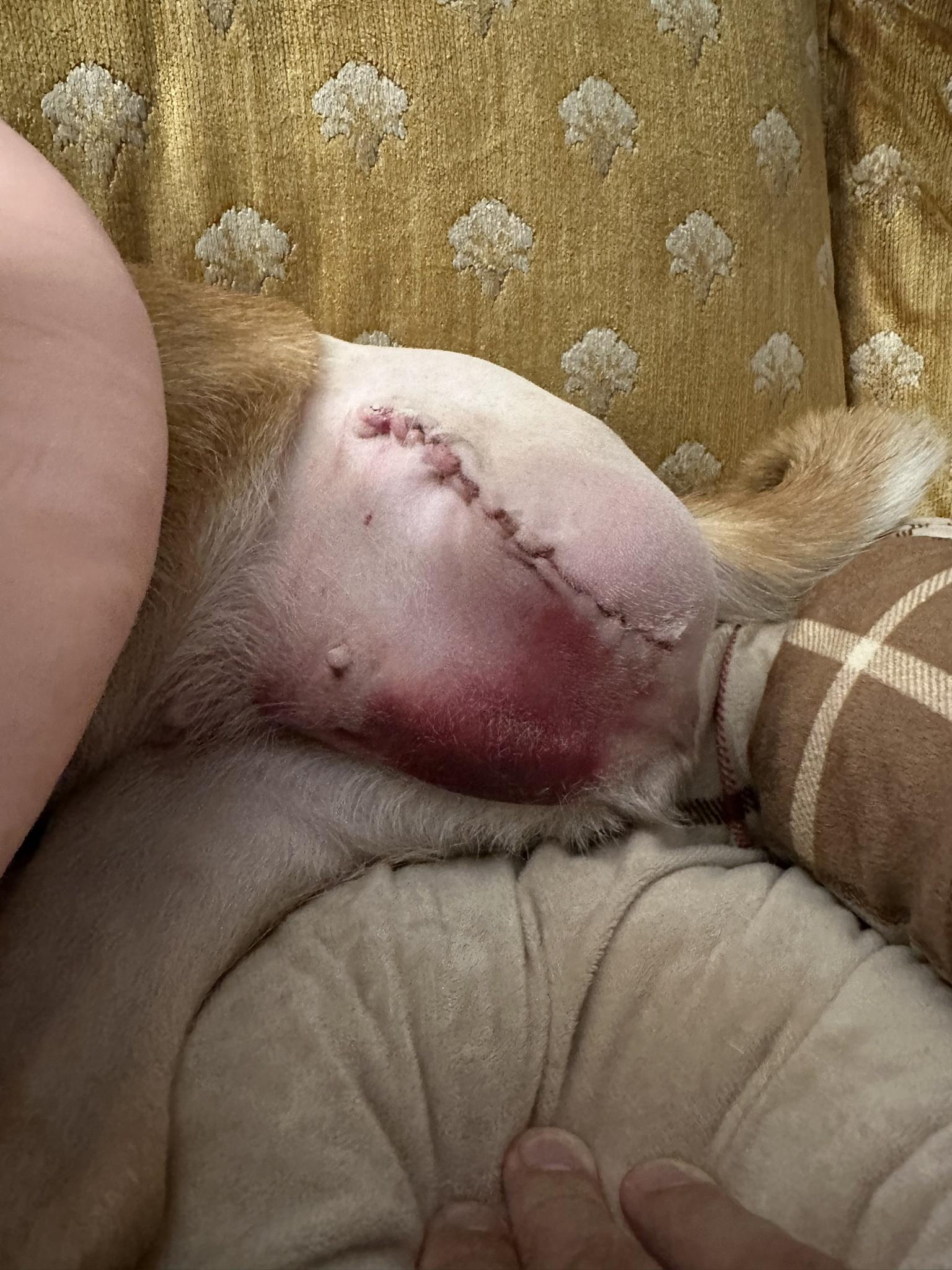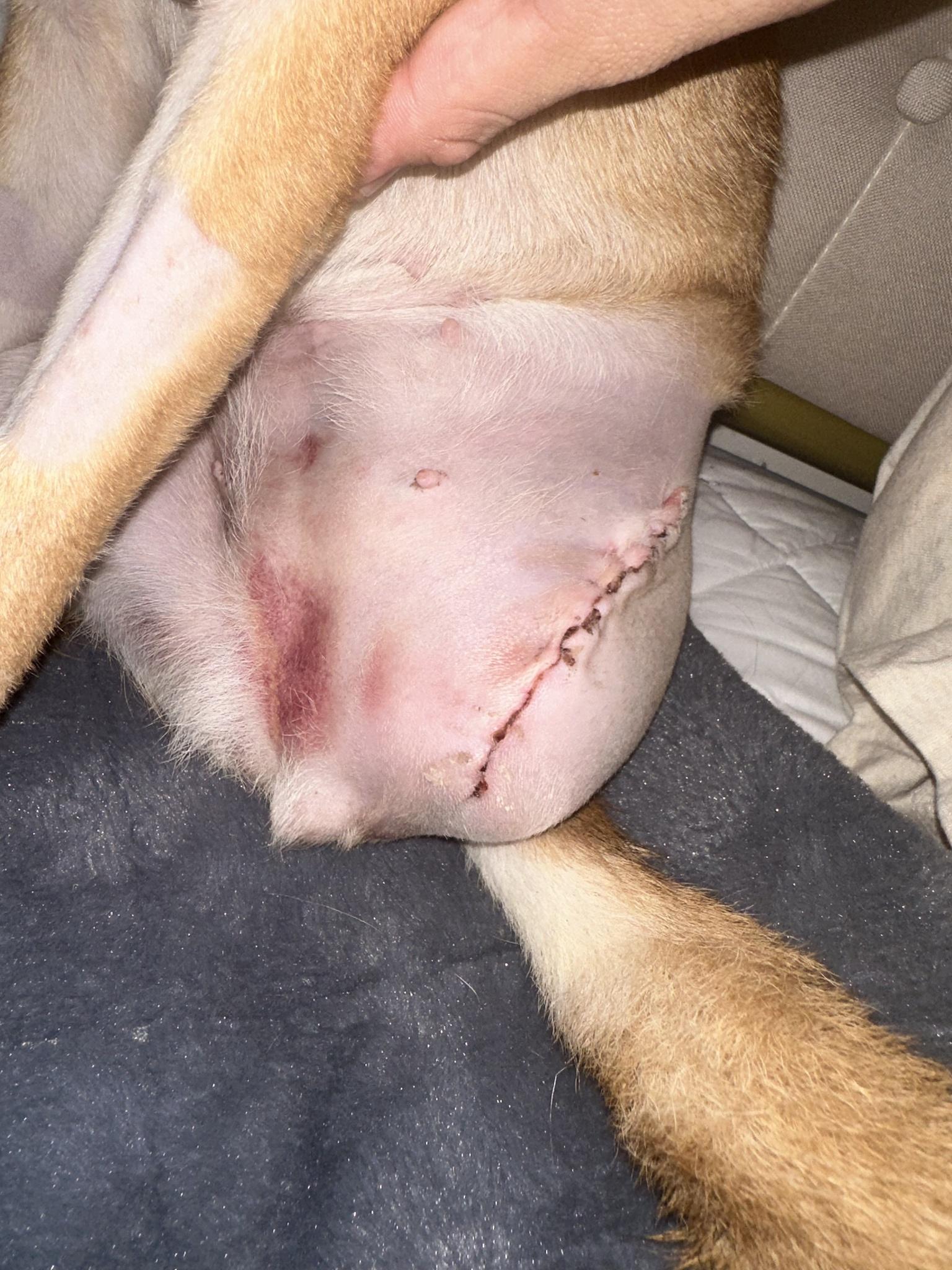One of the most worrisome things about a new Tripawd’s recovery is constantly wondering: is my cat or dog’s amputation bruise normal or not? Today let’s look at some before and after photos of bruising. Hopefully these will put your mind at ease.
The Cause of a Cat or Dog’s Amputation Bruise

First you should know that bruising is normal. It’s a side effect of amputation surgery. A big bruise happens because skin, muscles and tissues have been cut in order to remove the bad leg.
The amputation site becomes traumatized by the leg removal, and bruising appears soon after surgery.
A cat or dog’s amputation bruise looks worse before it gets better. The day after surgery, skin around the incision area will start turning into an angry, dark purplish color. Then for about the next five days, the bruises will lighten into shades of green, yellow, and light brown.
A dog’s amputation bruise looks bad, but don’t panic. But most bruises will fade over the next two weeks.
How to Tell if Your Dog’s Amputation Bruise is Normal or Not
Does this look concerning or just bruising?
Willow: Planning ahead for post-op recovery needs! @Chris_2

There’s not much you need to do about the bruising within the first three days unless your vet instructs you to do otherwise. Gentle heat and ice therapy can help minimize discomfort 72 hours after surgery. According to animal massage expert Wendy Richardson, you should wait until three days after amputation surgery to apply heat and ice therapy.
- First, apply heat for 3 minutes. Heat will loosen the fibers and increase blood flow to the area. Always test heat before application.
- Next, apply cold for 2 minutes. Ice reduces swelling and inflammation. Crushed ice can be used, wrapped in a thin towel for the cold application.
It’s even better today. Almost no red and a lot of the area is a very faint yellow now.
Willow: Planning ahead for post-op recovery needs! @Chris_2

Signs The Incision Area is NOT Normal Include
It’s a Tripawd’s amputation wound care that’s more important. But you don’t have to obsess or go overboard to keep it sterile. Just keep the wound area clean, don’t bandage or apply topical medications unless your vet tells you to.
Most amputation incisions need minimal care during recovery. But you do need to watch for signs that something is not normal, such as:
Foul smelling discharge leaking from the incision.
Is there any gross, cloudy, or stinky fluid draining from the incision? Normal drainage (a “seroma“) has a pink color, but is clear and doesn’t smell. If you suspect the discharge is not normal tell your vet.
Missing sutures or staples.
If sutures or staples fall out, this might be a sign that your dog’s incision is infected. The skin cannot heal, so the sutures or staples fall out. Also, if you see a wide gap (larger than ¼ inch) between the wound or tissue sticking out from the wound, call your vet immediately.
Excessive fluid drainage
Again, this is probably a seroma, which is a combination of blood and bodily fluid buildup that drains at the incision site. Seromas usually aren’t serious. Sometimes they need draining in a vet’s office. But tell your vet your dog is having one, just to be safe. And do your best to prevent a seroma by keeping your dog calm for at least a week after amputation. To much activity can ramp up the immune system and lead to excess fluid buildup.
 Join the forum discussion on this topic!
Join the forum discussion on this topic!
We took our girl in for a THR, her femur was fractured during the procedure. We tried 3 surgeries and we couldn’t repair her femur. They suspect cancer but we are waiting on pathology. She just had her leg amputated 9/24/24. Has anyone had the problem of their baby taking a couple steps and then sitting like something is hurting there back end?
Hi Lisa. I’m so sorry to hear about your pup! This behavior is typical of a dog who just had major surgery, but it also sounds like a dog whose pain needs stronger or more frequent medication. It sounds like her pain control could use some adjusting so please call your vet asap so they can fine tune her medications. With better pain control her mobility should improve. Please join our Forums and keep us posted OK?
Hello, my kitty just got a hind leg amputated after a femur fracture. Im seeing a lot of bruising on her back — on both sides of the spine above her tail. Is bruising in this area normal, or should i be concerned? Shes not having any trouble standing or walking, and tail movement is normal
Hi Caroline, sorry to hear about your cat’s amputation. Bruising is normal but generally only in the surgical area. I would take good photos and send them to your vet as soon as possible. Be sure to join us in the Tripawds Forums so we can support you during recovery and beyond.
we are right there with you. Our 5 1/2 year old golden broke his humerus due to what they also think is osteosarcoma… he had his front left limb removed- just trying to help him heal too
I need help. Our 10.5 yr old lab started a slight limp in early May that didn’t get better. He had a bone biopsy late May after which we were told he had chondrosarcoma and possibly an osteosarcoma complement in front R lower leg. The vet said amputate and send the limb in for further definitive dx. We saw his regular vet in the same clinic the next week and he suggested two weeks of intensive steroid treatment to shrink the cancer. This failed to make a difference. So he suggested amputation or he could refer us to cancer specialist or vet of our choosing. The amputation was done by our regular vet almost 3 weeks ago. Your days ago we got the report on the limb in his office when staples were removed. It showed osteosarcoma. All of our dog’s chest X-rays have been normal, one at the time of bone biopsy and another one the day of amputation. Now the MSU school of vet medicine lab says prognosis for his life is 14-19 weeks. We have chosen no chemo therapy and are bracing ourselves for a great loss. Our Labrador is otherwise healthy, has low energy at this point but normal appetite and bodily functions. What will the end look like for him? We are devastated
Hi Virginia, I am so sorry for the diagnosis and really glad that your dog is doing well after surgery. If you haven’t already, join us in the Forums where you will learn that a prognosis doesn’t guarantee anything. Many dogs outlive that depressing prognosis (including our Jerry, who lived two years post-amputation for osteosarcoma, without chemotherapy). A prognosis is based on other dogs, not your own. So please don’t focus on that number, because it’s really the only way that cancer will rob you of your time with him. Focus on the fact that he is healing, feeling better, and just wants you to be hoppy. As for what the end looks like, generally lung mets will happen and a cough as well as lethargy. Pretty common scenario. But again, focus on TODAY, ok?